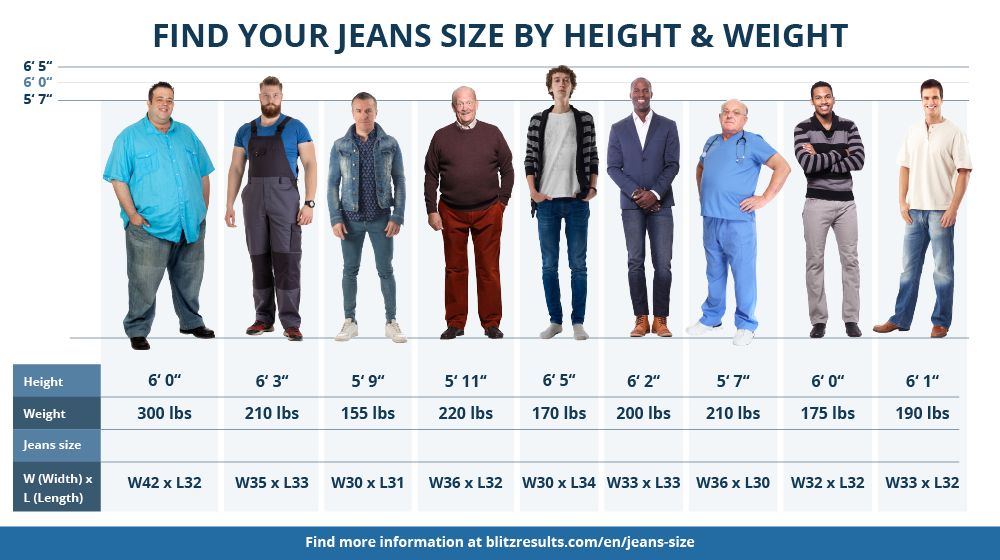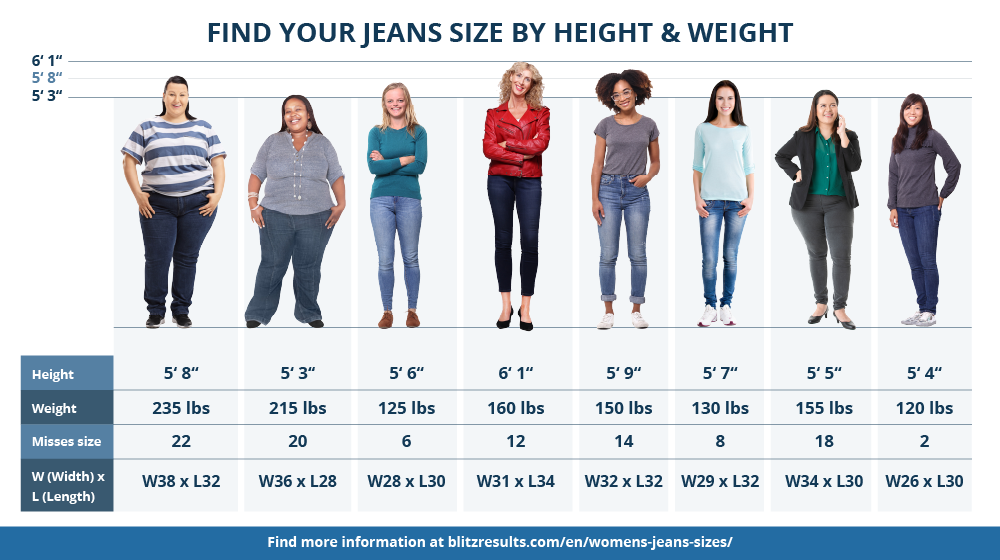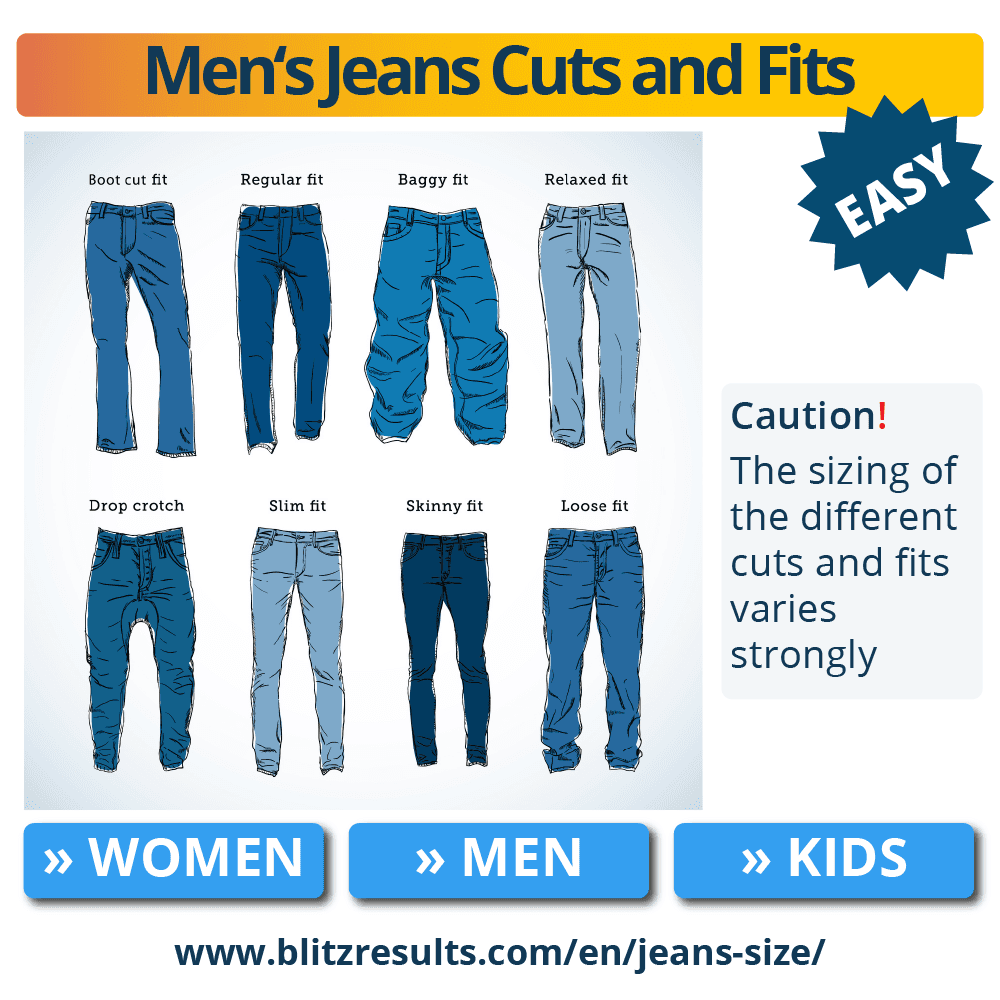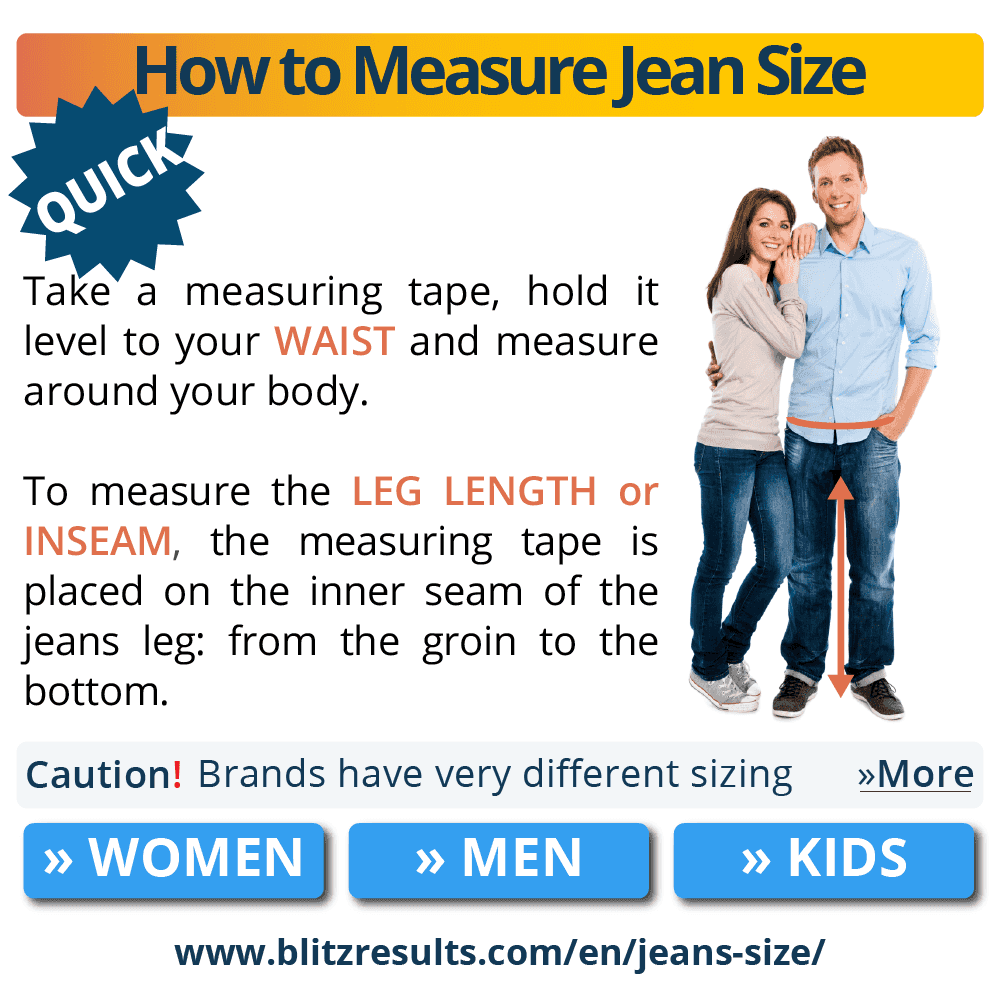This guide helps you find your jeans size, unraveling the complexities tied to both women’s and men’s jeans sizes.
Cracking the code for jeans sizes
Please note: There are no less than three different sizing systems for jeans in the US:
- The most common method of sizing combines waist width (W) and leg length (L), expressed in inches and in that order, e.g., 32×30. W = waist width = waist circumference; L = leg length = length of inner leg/inseam.
- International sizing, also known as Alpha or letter sizing, which usually runs from XS (extra small) to XL (extra large).
- For women only: US standard sizing or misses sizing, is rendered as one single number, such as that perfect size 6.

Jeans Size Charts for Men
In this conversion chart, you will find a broad spectrum of jeans sizes for men. The average size worn by most men in the US is a 36×32.
| Jean Size Men (W) | International Size | Waist (Inches) | Hip/Seat (Inches) |
|---|---|---|---|
| 28 | XS | 28-29" | 35-36" |
| 29 | S | 29-30" | 36-37" |
| 30 | S | 30-31" | 37-38" |
| 31 | M | 31-32" | 38-39" |
| 32 | M | 32-33" | 39-40" |
| 33 | M/L | 33-34" | 40-41" |
| 34 | L | 34-35" | 41-42" |
| 35 | L | 35-36" | 42-43" |
| 36 | XL | 36-37" | 43-44" |
| 38 | XL | 38-39" | 45-46" |
| 40 | XXL | 40-41" | 47-48" |
| 42 | XXL | 42-43" | 49-50" |
| 44 | XXXL | 44-45" | 51-52" |
| 46 | XXXL | 46-47" | 53-54" |
| 48 | XXXL | 48-49" | 55-56" |
| 50 | 4XL | 50-51" | 57-59" |
| 52 | 4XL | 52-53" | 59-61" |
| 54 | 5XL | 54-55" | 61-62" |
| 56 | 5XL | 56-57" | 63-64" |
Men’s Jeans Size Length (Inseam)
This chart is about finding your right jeans’ length according to your body height. What length of jeans should a 6-foot tall man wear? The answer is: jeans’ length should be 34” inseam length.
| Body height in feet and inches | Jeans Length (L) in Inches (Inseam) | SML-Size (Length Inseam) |
|---|---|---|
| 5'2''- 5'5'' | 28 | XS |
| 5'6'' - 5'7'' | 30 | S |
| 5'8'' - 6'0'' | 32 | M |
| 6'0'' - 6'4'' | 34 | L |
| 6'5'' - 6'6'' | 36 | XL |
| 6'7'' - 6'8'' | 38 | 2XL |
Jean Size Chart for Women
This chart boasts a gamut of jeans sizes for women. Measure your size, then check which jeans size corresponds to your measurements. The average woman wears a jeans size of 34×30.
| Jean Size Women (W) | US Misses Size | International Size | Waist (Inches) | Hip (Inches) |
|---|---|---|---|---|
| 23 | 00 | XXS | 23.5” - 24.5” | 33” - 34.5” |
| 24 | 0 | XXS | 24.5” - 25.5” | 34” - 35.5” |
| 25/26 | 2 | XS | 25.5” - 27.5” | 34.5” - 36.5” |
| 27 | 4 | XS | 27.5” - 28.5” | 37” - 38.5” |
| 28 | 6 | S | 28.5” - 29.5” | 38” - 39.5” |
| 29 | 8 | S | 29.5” - 30.5” | 39” - 40.5” |
| 30 | 10 | M | 30.5” - 31.5” | 40” - 41.5” |
| 31 | 12 | M | 31.5” - 32.5” | 41” - 42.5” |
| 32 | 14 | L | 32.5” - 33.5” | 42” - 43.5” |
| 33 | 16 | L | 33.5” - 34.5” | 43” - 44.5” |
| 34 | 18 | XL | 34.5” - 36.5” | 44.5” - 46.5” |
| 36 | 20 | XL | 36.5” - 38.5” | 46.5” - 48.5” |
| 38 | 22 | XXL | 38.5” - 40.5” | 48.5” - 50.5” |
| 40 | 24 | XXL | 40.5” - 42.5” | 50.5” - 52.5” |
| 42 | 26 | XXXL | 42.5” - 44.5” | 52.5” - 54.5” |
Women’s Jeans Size Length (Inseam)
What size jeans should I wear for my height? Find out the perfect length for your jeans with this jeans’ length guide by height.
| Body height in feet and inches | Jeans Length (L) in Inches (Inseam) | SML-Size |
|---|---|---|
| up to 5'3'' | 28'' | XS |
| 5'4'' - 5'5'' | 30'' | S |
| 5'6'' - 5'7'' | 32'' | M |
| 5'8'' - 5'10'' | 34'' | L |
| 5'11'' and taller | 36'' | XL |

Kids’ Jean Size Chart
| Kids Jeans Size | International Size | Age (years) | Waist (Inches) | Leg lenght (Inches) |
|---|---|---|---|---|
| 6 | S | 5 to 6 | 23'' | 19 - 20'' |
| 7 | M | 6 to 7 | 24'' | 21 - 23'' |
| 8 | M | 7 to 8 | 24.5'' | 23 - 24'' |
| 10 | L | 8 to 9 | 25.5'' | 24 - 26'' |
| 12 | XL | 9 to 10 | 26'' | 26 - 28'' |
| 14 | XL | 10 to 11 | 27-28'' | 28 - 30'' |
| 16 | XXL | 11 to 12 | 29-30'' | 30 - 31'' |
| 18 | XXXL | 12 to 13 | 30-31'' | 31 - 32'' |
What does the abbreviation W/L for jeans mean?
When it comes to W/L sizing, W stands for waist (width) and L for leg (length). These measurements, given in inches, always appear in this order. For example, if your jeans are labeled as size 36/32, the first number (36) indicates a waist width of 36 inches, while the second number (32) refers to a leg length of 32 inches.
Jeans Cuts and Fits and what they mean for your size
- Fit:
- Skinny: Fits extremely close, “painted on”.
- Slim: Tight but not as narrow as skinny.
- Regular: Traditional, leaves 2″-3″ slack, also “classic” or “original fit”.
- Relaxed: Baggiest width, also “loose fit” or “boyfriend jeans”.
- Cut:
- Tapered: Gradually tightens from knee to ankle.
- Straight: Equal knee and leg opening size.
- Bootcut: Larger leg opening than knee.
- Capri: Tighter than tapered, three-quarter-length.
- Flares: Widens into bell shape.
Find women’s jeans cuts here.

How to Measure Jeans Size

Here’s how you can easily measure your own jeans size at home. Either of these two simple and reliable methods will yield your accurate jeans size, that is, waist width and leg length:
- Measure body: With a level measuring tape, measure your waist for regular pants, or widest part of lower body for low-rise pants. Measure inner leg length from crotch to ankle or desired length. Adjust if you wear heels or want jeans to reach shoes/ankle.
- Measure jeans: Pick well-fitting jeans, lay flat, and measure waistband in inches, then double it. Measure inner seam from crotch to bottom corner of pant leg. The jeans size is the combination of these two measurements (waist/length).
Cracking the Code of Jean Sizes
- Men’s jeans sizes are typically consistent and use actual measurements in inches for both waist and length, unlike women’s jeans, which can vary significantly due to different fabrics and levels of stretch. Men’s jeans generally do not list hip sizes as their hip and waist sizes are similar. However, men’s jeans are designed with extra room in the crotch area, which might not suit women’s body shapes as well. High-waisted options in men’s jeans are uncommon. The lower crotch design of men’s jeans allows them to be pulled up above the hips for those who need or prefer that fit, although this might not work with skinny jeans that are designed to sit lower on the waist. Jeans labeled “Relaxed” or “Tapered” in men’s styles provide more room around the thighs and hips but lack the hip flare common in women’s jeans. The introduction of stretchy materials in men’s jeans offers more flexibility in fit.
- The variability in women’s jeans fit is often due to the use of various fabric types with different percentages of stretch. Designers do not necessarily account for this “give” in the sizing, making it more challenging to find the right fit. Women trying men’s jeans may need to choose a larger waist size to accommodate for their hip size, potentially requiring adjustments or the use of a belt to ensure a proper fit.
- Understand Denim Stretch: Jeans with 1-3% elastane (stretch) will loosen up about half a size during wear. Choose a snug fit initially. 100% cotton jeans (“rigid” denim) won’t stretch out much, so they should fit comfortably right from the start. If you’re buying 100% cotton jeans, remember they might shrink after washing. Ask sales staff about pre-shrunk options or buy a slightly larger size to compensate.
- Know Your Rise: The rise (distance from the crotch to the top of the waistband) affects fit significantly. Try different rises (high, mid, low) to see what suits your body shape and comfort preference best.
- Ignoring Size Labels: Sizes vary widely between brands. Focus on the fit, not the number. What’s labeled as a size 8 in one brand could be a 12 in another. Also try on different cuts: Skinny, straight, bootcut, and wide-leg jeans all fit differently. Try various styles to understand what flatters your shape and meets your comfort needs.
- Pay Attention to Fabric Weight: Lighter denim (under 12 oz.) tends to be softer and more flexible, while heavier denim (over 12 oz.) offers more structure and durability. Your choice should align with the comfort and look you’re after.
- Try on and do not rush: Sit down, squat, and move around in the jeans. They should be comfortable and not restrict movement. Check for gaping at the waistband or overly tight areas that could cause discomfort or unsightly bulging. Rushing the Process: Finding the perfect pair of jeans takes time. Don’t rush your shopping trip. Try on various styles and sizes to find your best fit.
- Tailoring Is Your Friend: If you find jeans that fit well in the hips and thighs but are too long or loose at the waist, consider getting them tailored for a perfect fit. It’s a relatively inexpensive way to get jeans that feel custom-made.
FAQ
How can I measure my jeans size at home?
To find your jeans size, measure your waistline where you usually wear a belt and note the circumference in inches. This is your waist size (W). Then measure your inner leg length from crotch to ankle or desired jeans end. This is your length (L). Alternatively, take a pair of well-fitting jeans, lay them flat, measure across the top of the waist (double this for your waist size), and measure from crotch to leg end for the length. More info.
What is the difference between jeans and pants sizes?
Try our easy guide on how to measure your jeans size and convert those measurements into the US, UK, Euro and international jeans sizes here, and a chart for pants sizes here. Use our jeans size chart to convert any standard pant size into a jeans size, for both men and women.
How do I find my size in jeans?
Jeans sizes are based on two measurements: waist circumference, or waist width (W) and length of the leg (L). The waist/length ratio is given in inches (in). For example: a waist size of 32 inches and leg length of 30 inches is a jeans size 32×30. Some brands also use alpha (as in “alphabetical”) sizing such as XS, S, M, L, XL, or US standard pants sizes, referred to in this conversion chart.
Insights from our Lab
This is how we work: watch the video and see how we measure and research in our lab.
- 1 Cracking the code for jeans sizes
- 2 Jeans Size Charts for Men
- 3 Men’s Jeans Size Length (Inseam)
- 4 Jean Size Chart for Women
- 5 Women’s Jeans Size Length (Inseam)
- 6 Kids’ Jean Size Chart
- 7 What does the abbreviation W/L for jeans mean?
- 8 Jeans Cuts and Fits and what they mean for your size
- 9 How to Measure Jeans Size
- 10 Cracking the Code of Jean Sizes
- 11 FAQ
- 12 Insights from our Lab
